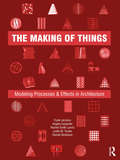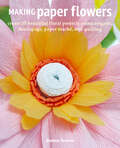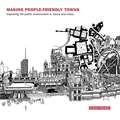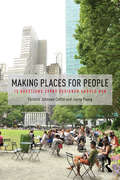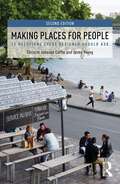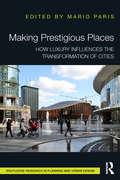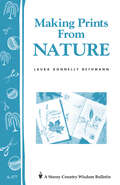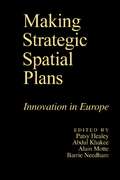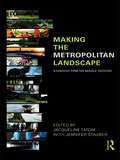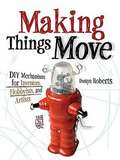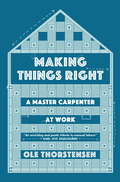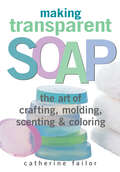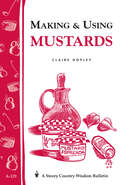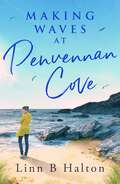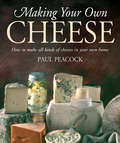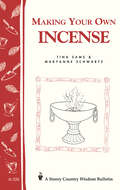- Table View
- List View
The Making of Things: Modeling Processes and Effects in Architecture
by Frank Jacobus Angela Carpenter Rachel Smith Loerts Justin M. Tucker Randal DickinsonThe Making of Things is about effect and intention in the schematic architectural model, a deep dive into the nature of architectonic form as the underlying syntax for all architectural work. By focusing on primitive geometries alongside fundamental principles of architectural thinking and making, this book enhances the reader’s capacity to intellectually and physically craft models that effectively communicate intention. With over 650 diagrams, this book acts as an expansive visual glossary that reveals the underlying structure of architectonics and acts as an encyclopedia of formal possibilities. Supporting essays in the book explore the nature of perception, abstraction, and metaphor to provide a theoretical basis of formal effects in architecture. This structure enables readers to make clear and direct connections between the things you construct and the reasons you construct them. This book is a bridge from the what to the why of form-making. It is a pedagogical notebook, a design primer that prompts discourse about the nature of objects. This is a must-have desk reference for beginning architecture and interior design students to stimulate their creative approaches and gain foundational knowledge of the underlying effects of formal typologies and how they manifest themselves in built forms around the world.
Making Paper Flowers
by Denise BrownCreate your own stunning flowers from paper with these 35 step-by-step projects. Decorate your home using techniques such as simple origami, layered découpage, papier mâché and quilling. Using everyday giftwrap, colourful pages torn from glossy magazines, paper napkins and tissue paper to handmade paper, parchment paper and crinkly crepe paper, Denise Brown guides you through the process of making perfect paper flowers. You can display the flowers in vases, create bouquets and posies to give as gifts, use them to decorate gift boxes and greetings cards, or create wall hangings and window displays. Whether your taste is rooted in Simple yet Stunning, where you will find Oriental Poppies and Frilly Fancies, or Bright and Beautiful, with projects such as Vibrant Dahlias and Waterlilies, or finally, Sophisticated Style, where you can make a Peony Wreath or Elegant Lilies, you will be sure to find the perfect project. Making Paper Flowers is a fantastic new edition of the previously published Paper Flowers.
Making People-Friendly Towns: Improving the Public Environment in Towns and Cities
by Francis TibbaldsMaking People-Friendly Towns explores the way our towns and cities, particularly their central areas, look and feel to all their users and discusses their design, maintenance and management. Francis Tibbalds provides a new philosophical approach to the problem, suggesting that places as a whole matter much more than the individual components that make up the urban environment such as buildings, roads and parks. This informative book suggests the way forward for professionals, decision-makers and all those who care about the future of our urban environment and points the reader in the direction of a wealth of living examples of successful town planning.
Making People-Friendly Towns: Improving the Public Environment in Towns and Cities
by Francis TibbaldsMaking People-Friendly Towns explores the way our towns and cities, particularly their central areas, look and feel to all their users and discusses their design, maintenance and management. Francis Tibbalds provides a new philosophical approach to the problem, suggesting that places as a whole matter much more than the individual components that make up the urban environment such as buildings, roads and parks. This informative book suggests the way forward for professionals, decision-makers and all those who care about the future of our urban environment and points the reader in the direction of a wealth of living examples of successful town planning.
Making Places for People: 12 Questions Every Designer Should Ask
by Christie Johnson Coffin Jenny Young** Honorable Mention at the 2019 ERDA Great Places Awards ** Making Places for People explores twelve social questions in environmental design. Authors Christie Johnson Coffin and Jenny Young bring perspectives from practice and teaching to challenge assumptions about how places meet human needs. The book reveals deeper complexities in addressing basic questions, such as: What is the story of this place? What logic orders it? How big is it? How sustainable is it? Providing an overview of a growing body of knowledge about people and places, Making Places for People stimulates curiosity and further discussion. The authors argue that critical understanding of the relationships between people and their built environments can inspire designs that better contribute to health, human performance, and social equity—bringing meaning and delight to people’s lives.
Making Places for People: 12 Questions Every Designer Should Ask
by Christie Johnson Coffin Jenny Young** Honorable Mention at the 2019 ERDA Great Places Awards ** Making Places for People explores twelve social questions in environmental design. Authors Christie Johnson Coffin and Jenny Young bring perspectives from practice and teaching to challenge assumptions about how places meet human needs. The book reveals deeper complexities in addressing basic questions, such as: What is the story of this place? What logic orders it? How big is it? How sustainable is it? Providing an overview of a growing body of knowledge about people and places, Making Places for People stimulates curiosity and further discussion. The authors argue that critical understanding of the relationships between people and their built environments can inspire designs that better contribute to health, human performance, and social equity—bringing meaning and delight to people’s lives.
Making Places for People: 12 Questions Every Designer Should Ask
by Christie Johnson Coffin Jenny YoungMaking Places for People explores 12 social questions crucial to environmental design. Authors Christie Johnson Coffin and Jenny Young bring perspectives from practice and teaching to challenge assumptions about how places meet human needs. In this expanded second edition, the authors continue to explore the complexities of basic questions, such as: What is the story of this place? What logic orders it? How big is it? How sustainable is it? They consider the impact on making places of pandemic, climate change, human migration, and contemporary discussions of diversity, equity, and justice. Short, approachable, easy-to-read chapters, illustrated with updated examples of projects from around the world, bring together theory, methodology and key research findings. Understanding experienced and research-based connections between people and built form can inspire designs that make places of meaning and delight. This second edition will be essential reading for design students and professionals.
Making Places for People: 12 Questions Every Designer Should Ask
by Christie Johnson Coffin Jenny YoungMaking Places for People explores 12 social questions crucial to environmental design. Authors Christie Johnson Coffin and Jenny Young bring perspectives from practice and teaching to challenge assumptions about how places meet human needs. In this expanded second edition, the authors continue to explore the complexities of basic questions, such as: What is the story of this place? What logic orders it? How big is it? How sustainable is it? They consider the impact on making places of pandemic, climate change, human migration, and contemporary discussions of diversity, equity, and justice. Short, approachable, easy-to-read chapters, illustrated with updated examples of projects from around the world, bring together theory, methodology and key research findings. Understanding experienced and research-based connections between people and built form can inspire designs that make places of meaning and delight. This second edition will be essential reading for design students and professionals.
Making Prestigious Places: How Luxury Influences the Transformation of Cities
by Mario ParisMaking Prestigious Places investigates the spatial dimension of luxury, both as a sector involving activities, operators and investments, and as a system of values acting as a catalyst for recent urban transformations. Luxury shares a well-established connection to the city, as a place of production, consumption and self-representation, and continues to grow despite economic difficulties. This edited collection includes case studies from Europe, North and South America, Asia and the Middle East to create a dialogue around these developments and the challenges presented, such as the tension between the idea of prestige and current values in urban planning, the discussion between academic reflections and operational practices, and how these interact with the long-term economic and social dynamic of the city. With rich analysis and a preface written by Patsy Healey, this book will be an important addition to the discourse on luxury for urban planners and researchers.
Making Prestigious Places: How Luxury Influences the Transformation of Cities
by Mario ParisMaking Prestigious Places investigates the spatial dimension of luxury, both as a sector involving activities, operators and investments, and as a system of values acting as a catalyst for recent urban transformations. Luxury shares a well-established connection to the city, as a place of production, consumption and self-representation, and continues to grow despite economic difficulties. This edited collection includes case studies from Europe, North and South America, Asia and the Middle East to create a dialogue around these developments and the challenges presented, such as the tension between the idea of prestige and current values in urban planning, the discussion between academic reflections and operational practices, and how these interact with the long-term economic and social dynamic of the city. With rich analysis and a preface written by Patsy Healey, this book will be an important addition to the discourse on luxury for urban planners and researchers.
Making Prints from Nature: Storey's Country Wisdom Bulletin A-177 (Storey Country Wisdom Bulletin)
by Laura Donnelly BethmannSince 1973, Storey's Country Wisdom Bulletins have offered practical, hands-on instructions designed to help readers master dozens of country living skills quickly and easily. There are now more than 170 titles in this series, and their remarkable popularity reflects the common desire of country and city dwellers alike to cultivate personal independence in everyday life.
Making Strategic Spatial Plans
by Patsy HealeyA pan-European survey of strategic planning issues in response to technological innovation and its spatial consequences, this text should interest all planners, geographers and others concerned wtih the planning and management of economic development.
Making Strategic Spatial Plans
by Patsy Healey Abdul Khakee Alain Motte Barrie NeedhamA pan-European survey of strategic planning issues in response to technological innovation and its spatial consequences, this text should interest all planners, geographers and others concerned wtih the planning and management of economic development.
Making the Metropolitan Landscape: Standing Firm on Middle Ground
by Jacqueline Tatom Jennifer StauberThe American landscape is an extremely complex terrain born from a history of collective and individual experiences. These created environments, which all may be called metropolitan landscapes, constantly challenge students and professionals in the fields of architecture, design and planning to consider new ways of making lively public places. This book brings together varied voices in urban design theory and practice to explore new ways of understanding place and our position in it.
Making the Metropolitan Landscape: Standing Firm on Middle Ground
by Jacqueline Tatom Jennifer StauberThe American landscape is an extremely complex terrain born from a history of collective and individual experiences. These created environments, which all may be called metropolitan landscapes, constantly challenge students and professionals in the fields of architecture, design and planning to consider new ways of making lively public places. This book brings together varied voices in urban design theory and practice to explore new ways of understanding place and our position in it.
Making Things Move DIY Mechanisms (PDF)
by Dustyn RobertsIn Making Things Move: DIY Mechanisms for Inventors, Hobbyists, and Artists, you'll learn how to successfully build moving mechanisms through non-technical explanations, examples, and do-it-yourself projects--from kinetic art installations to creative toys to energy-harvesting devices. Photographs, illustrations, screen shots, and images of 3D models are included for each project. This unique resource emphasizes using off-the-shelf components, readily available materials, and accessible fabrication techniques. Simple projects give you hands-on practice applying the skills covered in each chapter, and more complex projects at the end of the book incorporate topics from multiple chapters. Turn your imaginative ideas into reality with help from this practical, inventive guide.
Making Things Right: A Master Carpenter at Work
by Ole ThorstensenA celebration of good craftsmanship by a Norwegian master carpenter - the anatomy of a job well done."An enriching and poetic tribute to manual labour" Karl Ove Knausgård"In Thorstensen's skilled hands, the everyday story of a suburban loft conversion is turned into an urgent study on the value of doing good work. It should be widely read." Robert Penn - author of The Man Who Made Things Out of TreesThis is, quite simply, the story of a loft conversion. It is also a book about work and identity, about collaboration and pride in skilled craftsmanship, and about what it means to make things with your hands in a consumerism-driven world. A master carpenter and builder with thirty years' experience, Thorstensen gives a matter-of-fact, reflective voice to the workers who construct our living spaces and our urban environment. He looks upon his tools as an important part of himself and as a reflection of his respect for his trade, and he addresses the gulf in understanding and communication between skilled craftsmen and "academic" workers. From the moment of a client's phone call to their occupation of a newly constructed living space, Making Things Right tracks the project as it takes shape: the delicate negotiation to establish an optimum plan; the collaboration with a trusted team of specialist painters, plasterers, plumbers, electricians; the handling of materials; the blood, sweat and frustration involved in doing a job well. Why is it that manual skills are underestimated? After all, working with your hands gives you time to think. With all its practical detail, Making Things Right is the simple philosophy of a working life.Will interest readers of The Craftsman by Richard Sennett: Kitchen Confidential by Anthony Bourdain; The Man Who Made Things Out of Trees by Robert Penn; Do No Harm by James Marsh and A Shepherd's Life by James RebanksTranslated from the Norwegian by Sean Kinsella
Making Transparent Soap: The Art Of Crafting, Molding, Scenting & Coloring
by Catherine FailorWith basic ingredients and standard kitchen tools you can craft your own transparent soaps that are milder, richer, and creamier than any commercial product. Eschewing complex methods and expensive equipment, Catherine Failor uses a simple, dependable process that makes beautiful transparent soaps every time. Failor&’s easy-to-follow photographic instructions are accompanied by proven recipes and plenty of suggestions for colorful and sweet-smelling variations. You&’ll soon be creating your own signature soap blends that deliver refreshing scents and are gentle enough for even the most sensitive skin.
Making & Using Mustards: Storey's Country Wisdom Bulletin A-129 (Storey Country Wisdom Bulletin)
by Claire HopleySince 1973, Storey's Country Wisdom Bulletins have offered practical, hands-on instructions designed to help readers master dozens of country living skills quickly and easily. There are now more than 170 titles in this series, and their remarkable popularity reflects the common desire of country and city dwellers alike to cultivate personal independence in everyday life.
Making Waves at Penvennan Cove (The Penvennan Cove series)
by Linn B. HaltonKerra Shaw feels that all the pieces of her life are finally coming together. She has a fulfilling job helping small businesses in the local community and, most importantly, she has finally got together with her childhood sweetheart, Ross Treloar.But it's not all plain sailing, with an old family feud raging on between Kerra's dad and the Treloar family, it's best to keep her new relationship behind closed doors to avoid gossip.Still, Kerra should know better than anyone that secrets don't stay hidden for long in the small, Cornish village of Penvennan Cove... As other truths come to light will her relationship with Ross be put to the test?The second uplifting and feel-good romance novel in a gorgeous series set in the Cornish community of Penvennan Cove. Can be read as a standalone but best read as a part of the series! Perfect for fans of Lucy Coleman, Jessica Redland and Lisa Hobman.
Making Your Own Cheese: How to Make All Kinds of Cheeses in Your Own Home
by Paul PeacockNot everyone can keep a cow, but everyone can make cheese. This book shows you the very basic equipment needed to make your own cheese: the ingredients, including different milks, herbs and flavours; how to make a simple cheese; and how to produce some of the worlds speciality cheeses such as Roquefort, Brie and Edam. You will find recipes for making many cheeses at home. Whether you are making a cheese cake, a ricotta-based pudding or a stonking salty blue, this book is a cheese lover s guide to making their own favourite food and there are some recipes for the biscuits to go with it, too.
Making Your Own Incense: Storey Country Wisdom Bulletin A-226 (Storey Country Wisdom Bulletin)
by Tina Sams Maryanne SchwartzSince 1973, Storey's Country Wisdom Bulletins have offered practical, hands-on instructions designed to help readers master dozens of country living skills quickly and easily. There are now more than 170 titles in this series, and their remarkable popularity reflects the common desire of country and city dwellers alike to cultivate personal independence in everyday life.
Male fern (large print)
by RnibThis image shows a Male fern (Dryopteris felis-mas) with rolled immature fronds (leaves), rhizome and roots.There is a locator dot shown, which will be at the top left of the page when the image is the correct way up.The plans roots are at the bottom of the page growing from the rhizome above.There are immature fronds growing up from the left part of the rhizome. They are coiled up in spirals and will unwind to develop into mature fronds like the one to their right.The mature frond grows up and right to the top right of the page. It has a central stem with individual leaflets (pinna) growing out and up to the left and right, getting smaller towards the top of the frond. These leaflets are made up of even smaller leaflets called pinnules. These are shown on this image as a serrated edge to the pinna.The fern is a primitive plant without flowers or seeds. It reproduces instead, by releasing spores from sporangia on the underside of its leaves; these are not shown.
Male fern (UEB contracted)
by RnibThis image shows a Male fern (Dryopteris felis-mas) with rolled immature fronds (leaves), rhizome and roots.There is a locator dot shown, which will be at the top left of the page when the image is the correct way up.The plans roots are at the bottom of the page growing from the rhizome above.There are immature fronds growing up from the left part of the rhizome. They are coiled up in spirals and will unwind to develop into mature fronds like the one to their right.The mature frond grows up and right to the top right of the page. It has a central stem with individual leaflets (pinna) growing out and up to the left and right, getting smaller towards the top of the frond. These leaflets are made up of even smaller leaflets called pinnules. These are shown on this image as a serrated edge to the pinna.The fern is a primitive plant without flowers or seeds. It reproduces instead, by releasing spores from sporangia on the underside of its leaves; these are not shown.
Male fern (UEB uncontracted)
by RnibThis image shows a Male fern (Dryopteris felis-mas) with rolled immature fronds (leaves), rhizome and roots.There is a locator dot shown, which will be at the top left of the page when the image is the correct way up.The plans roots are at the bottom of the page growing from the rhizome above.There are immature fronds growing up from the left part of the rhizome. They are coiled up in spirals and will unwind to develop into mature fronds like the one to their right.The mature frond grows up and right to the top right of the page. It has a central stem with individual leaflets (pinna) growing out and up to the left and right, getting smaller towards the top of the frond. These leaflets are made up of even smaller leaflets called pinnules. These are shown on this image as a serrated edge to the pinna.The fern is a primitive plant without flowers or seeds. It reproduces instead, by releasing spores from sporangia on the underside of its leaves; these are not shown.
